The Star Of Your God
Grace and peace, Saints.
Below is the present coat of arms of Pope Francis, which features the emblem of the Jesuit order.
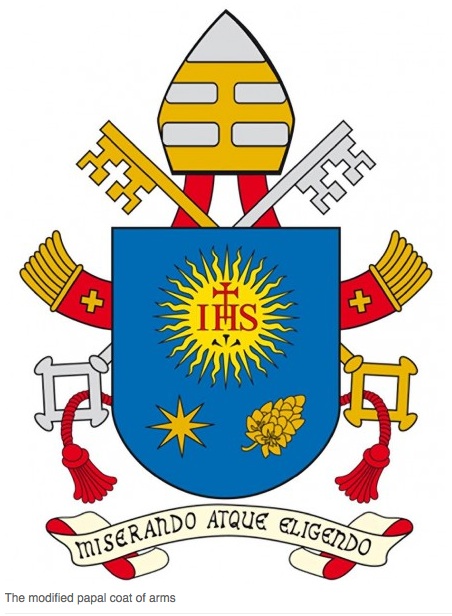
This is actually the modified version. The original design featured essentially the same three elements, but slightly different in form:
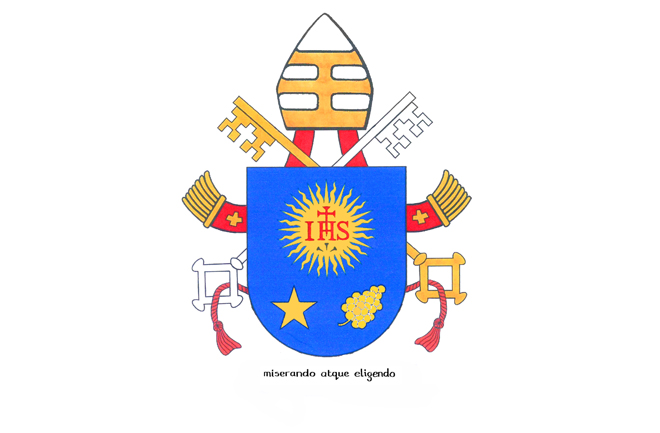
You will notice that the five-pointed star and bunch of grapes, that were present in the original design, have been replaced with an eight-pointed star and “spikenard flower.”
You may recall that in our post, The Roman Catholic Church, Zionism, Stars, and Seashells, we relate how the apostate Jews worshipped a star which represented a pagan idol (Amos 5:26, Acts 7:43). So, my antenna went up when I saw both the five- and six-pointed stars on the emblem of the papacy.
Interestingly, The Catholic Herald says that the eight-pointed star has always been a symbol for Mary.
“Italian Cardinal Andrea Cordero Lanza di Montezemolo, an expert on heraldry said that changing the star was ‘better’ because the five-pointed star often carries with it ‘military significance,’ while the eight-pointed star ‘has always symbolised Mary’ in Catholic Church tradition.” [Boldface mine, quotations in original.]
Again, the Bible says the apostate Jews also worshipped a star:
“But ye have borne the tabernacle of your Moloch and Chiun your images, the star of your god, which ye made to yourselves”.
Amos 5:26
“Yea, ye took up the tabernacle of Moloch, and the star of your god Remphan, figures which ye made to worship them.”
Acts 7:43
Now, think saints.
Mystery Babylon is the worship of Nimrod and Semiramis, the first king and queen of ancient Babylon. Semiramis was called The Virgin and is said to have been worshipped the world over (Alexander Hislop, The Two Babylons). The apostate Jews worshipped an idol, which they represented with a star. The Greek word for star is astor (Oxford Dictionary of English). The apostate Jews also worshipped a goddess called Ashtoreth (1 Kings 11:5). Ashtoreth was also called Astarte and Ishtar, and was the Phoenician goddess of sexual love (Strong’s Concordance). This identifies Ashtoreth with Diana (Modern Catholic Dictionary), the Roman goddess of sexual love (Oxford).
The Bible says that the Ephesians also worshipped a goddess called Diana, who was worshipped the world over (Acts 19:24-27). Diana is identified with Aphrodite, the Greek goddess of sexual love (Oxford). Aphrodite was also the goddess of the sea (Oxford)(Aphrodite means “foam born”). This identifies Aphrodite with Venus, the Roman goddess of the sea. The Latin word for sea is mari or mare (Oxford). The Roman Catholic church worships a goddess called Mary. Mary is called The Virgin and the goddess of the moon, which identifies her with Diana, the Roman goddess of the moon (Oxford, Modern Catholic Dictionary). Diana was also the goddess of virginity (Oxford), which identifies her with Diana of Ephesus, who was worshipped as a virgin (Hislop), and Semiramis, the Virgin Queen of Babylon (Hislop). Both Diana of Ephesus and Semiramis were worshipped all over the world (Acts 19:24-27, Hislop).
The apostate Jews worshipped a star to symbolize their goddess and they also worshipped Ashtoreth. If all goddesses are really Semiramis, then Ashtoreth is Semiramis. The Jews worshipped a star that was the symbol of their goddess, and the Roman Catholic church uses the eight-pointed star to symbolize Mary, who is also a goddess. If all goddesses are really Semiramis, then Mary is Semiramis. And if the eight-pointed star symbolizes Mary, then the eight-pointed star symbolizes Semiramis.
The eight-pointed star is also a symbol of the Hindu goddess Lakshmi:
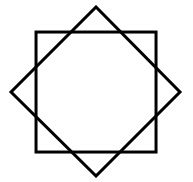
According to Eric W. Weisstein, the above figure is called the asthalakshmi or Star of Lakshmi. If all goddesses are the same goddess, then Lakshmi is Semiramis, who was also worshipped as Venus, Ashtoreth, and now, the Virgin Mary.
Now, I’ve got a question for you. Is only the eight-pointed star a symbol for Mary, or are all stars symbols for Mary? Well, consider that the eight-pointed star was chosen for Pope Francis’ coat of arms, because it symbolizes his “particular devotion to the Holy Virgin,” but the five-pointed star was chosen first and was only rejected because it carried “a military significance.” If the eight-pointed star was chosen to represent Mary, and the five-pointed star only rejected because of its martial connotation, could it be that the five-pointed star also represents Mary? It’s at least worth considering.
The Bible says there is nothing new under the sun. If, therefore, the apostate Jews worshipped a goddess before, then the apostate Jews worship a goddess now. Likewise, if the apostate Jews worshipped a star to represent their goddess before, then they worship a star to represent their goddess today.
As we showed you in Zionism, Stars, and Seashells, the logo of the World Zionist Organization (WZO) features a Star of David with what is supposed to be a menorah, fashioned in the shape of a seashell. The seashell is a symbol for the goddess Venus, the goddess of the sea, also called Mary.

The Roman Catholic church uses the seashell to represent the goddess Mary, and Pope Benedict XVI uses it on his coat of arms.
The apostate Jews worshipped a star that represented their goddess, and the Roman Catholic church uses the seashell and the eight-pointed star to symbolize their goddess. The WZO logo features the seashell and a six-pointed star. In the world of symbolism one thing is often associated with another by placing the two together. If this is true of the WZO logo, then we can assume that the six-pointed star and the seashell are intended to represent the same thing. If, therefore, the seashell represents the goddess, then the six-pointed star also represents the goddess. If the goddess is called Mary, then the six-pointed star also represents Mary.
It is possible, then, that both the eight- and six-pointed stars represent Mary.
But what if not only the six- and eight-pointed stars were symbols for Mary, but all stars? The following remarks and images provided by Marielena Montesino de Stuart in an article for the Catholic Herald entitled, It’s All In The Stars…Socialism and the Vatican would seem to suggest that very thing:
“Is the five-pointed star found in Mariology (Mary worship)? Of course!
“The assumption of Mary in Attard, Malta and the Miraculous Medal, as revealed by the Virgin Mary to Saint Catherine Laboure’.” [Parentheses mine.]
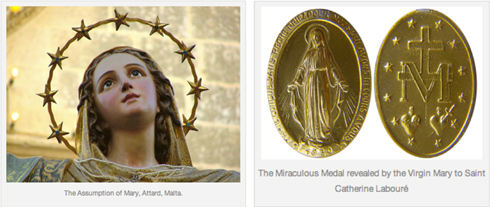
"The image of the Pilgrim Virgin of Fatima was made according to indications by Sister Lúcia, and was a gift from the Bishop of Leiria – and solemnly crowned by the Archbishop of Évora, on May 13, 1947."
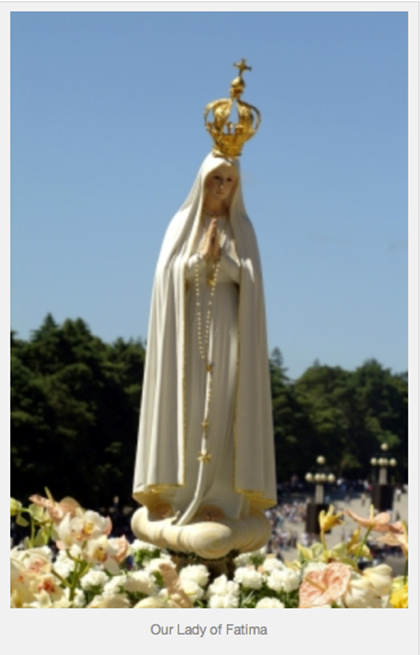
"Basilica of Our Lady of Scherpenheuvel, Belgium. The recurrent use of the number seven (in the shape of the church and the town, the number of altars outside and inside, the shape of the stars on the dome) recalls the devotion to the Seven Sorrows of the Virgin. Both the church and the town of Scherpenheuvel are in fact determined by a Hortus Conclusus in the shape of a heptagon."
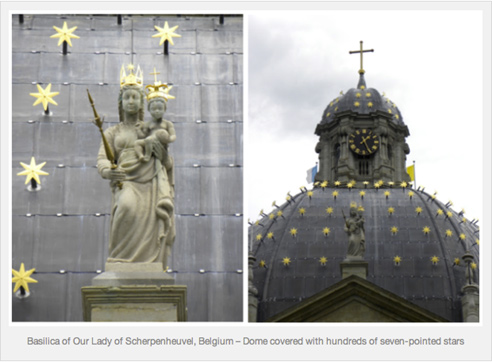
"Are sun rays found in Mariology? Of course! Our Lady of the Gate of Dawn, Vilnius, Lithuania."
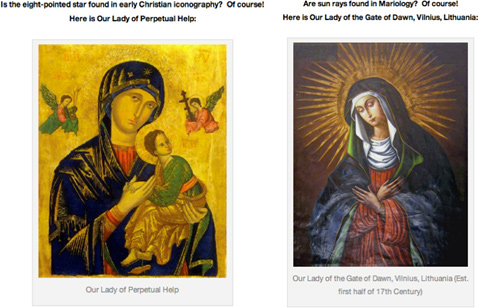
If we can believe the testimony of Ms. de Stuart, then the five-, six-, seven-, and eight-ponted stars are all symbols for the Roman Catholic Virgin Mary, as well as sun rays. And if the five-, six-, seven-, and eight-pointed stars are symbols for the Virgin Mary, then, as far as I’m concerned, all stars are symbols for the Virgin Mary.
But if Mystery Babylon is the worship of Nimrod and Semiramis, then they both have to be represented on the modern-day symbol for Mystery Babylon. If the Roman Catholic church is modern-day Babylon, and their pope is its head, then both Nimrod and Semiramis should be represented in the seal of the pope. Again, I’m not into the occult, so I don’t know for sure. But this is my reasoning.
Pope Benedict XVI’s papal coat of arms, for instance, features a black king and a seashell:
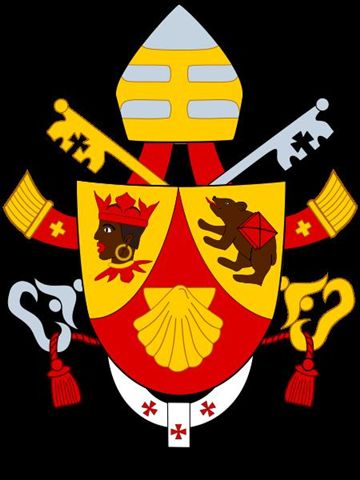
As we know, the seashell is a symbol for Mary, and Mary is really Semiramis. So it is safe to assume that the black king is Nimrod. Nimrod was the son of Cush and the grandson of Noah. Cush was black.
The Catholic Herald says that the eight-pointed star is Mary, and we know that Mary is really Semiramis. But where is Nimrod in Pope Francis’s coat of arms?
Well, consider that Pope Francis’ coat of arms features the logo of the Jesuits, which features a blazing sun:
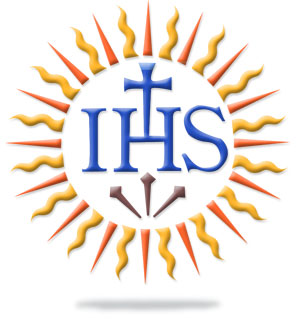
It is said that when Nimrod was killed, he was deified as The Sun God (Hislop). That is why all gods, which are really Nimrod, are also associated with the sun. This is true of Apollo, Horus, Hermes, Odin, Wotan, Ganesh, Shiva, Zoroaster, Quetzalcoatl, and others. Could the Jesuit sun be a symbol for Nimrod? It’s at least worth considering. If the Jesuit sun does represent Nimrod, then Mystery Babylon is symbolized in Pope Francis’ coat of arms.
Are you ready to see something scary? The number of points (as well as rays) in the Jesuit sun add up to sixteen. Guess who else uses a symbol that features a shield with a star containing sixteen points?
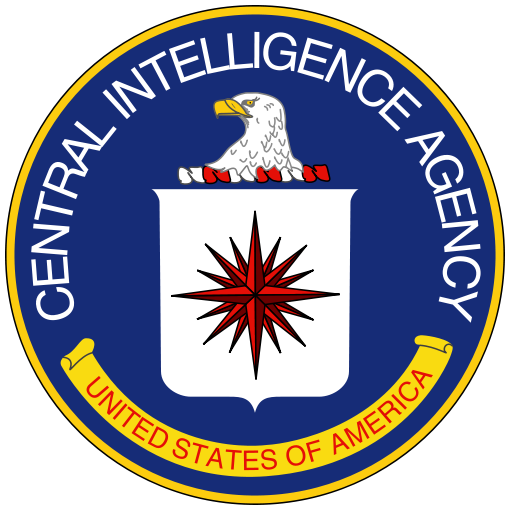
Coincidence? I would like to think so, but I don’t.
Acts 7:43 says that the apostate Jews worshipped “figures” (plural) that they made to worship “them” (also plural). Since figures refers to the star, and them refers to Moloch and Remphan, then it can be assumed that the apostate Jews used more than one type of star to refer to Moloch and Remphan. We know that Moloch means king, and was a name used to refer to Nimrod. Remphan, therefore, must be Semiramis. We know for sure that the eight-pointed star represents Semiramis, and it is possible that the six- and five-pointed stars represent her also. What, then, was used to represent Nimrod? Well, consider that the sun is a star.
For convincing evidence that all stars are symbols for the Virgin Mary, read The Star of the Sea and The Two Marys. If these articles don’t convince you that the Virgin Mary is the goddess Semiramis, the Virgin Queen of Babylon, and that stars are symbols for her, then nothing will.
Be encouraged and look up, for your redemption draweth nigh.
The Still Man
Comments
The Star Of Your God — No Comments
HTML tags allowed in your comment: <a href="" title=""> <abbr title=""> <acronym title=""> <b> <blockquote cite=""> <cite> <code> <del datetime=""> <em> <i> <q cite=""> <s> <strike> <strong>